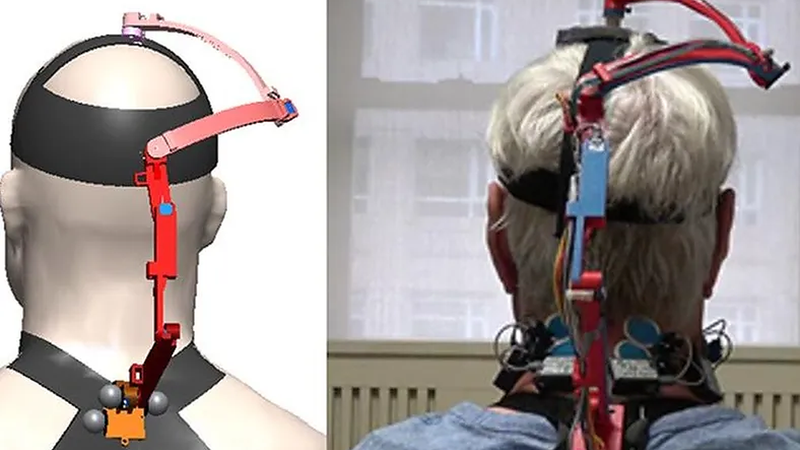Podcast: Detecting Cancer In Pee, Robotic Neck Brace, Quieter Airplanes
In this episode, we talk about how MIT engineers have proven a way to detect the presence of origin for cancer cells in pee using nanoparticles, the robotic neck brace developed by Columbia University researchers, and a novel method to reduce the noise generated by airplanes during landing.

Schematic of the new robotic neck brace and a picture of a subject using the brace. (Left) A CAD drawing of the neck brace. (Right) A participant wearing the brace during experiments while sitting comfortably on a chair. Surface electrodes are mounted in the head and neck area to record muscle activity. Photo Credit: Sunil K. Agrawal, Roar Lab.
In this episode, we talk about how MIT engineers have proven a way to detect the presence and location of origin for cancer cells in pee using nanoparticles, the robotic neck brace developed by Columbia University researchers to accurately diagnose the source of neck pain in cancer patients, and a novel method to reduce the noise generated by airplanes during landing proposed by Texas A&M. As always, you can find these and other interesting & impactful engineering articles on Wevolver.com.
EPISODE NOTES
(0:55) - Using Nanoparticles To Detect Cancer In Pee:
A team of MIT engineers have come up with a way to detect the presence of cancer and localize the region of origin by analyzing a patient’s pee sample. The patient can either inhale or be injected with nanoparticles that’ll exit the body via urine and a paper test - similar to over the counter pregnancy tests - can be used to determine if the patient has cancer. Additionally, if the patient does test positive, the nanoparticles can be coated with a radioactive tracer to show medical professionals the source of the growth via PET scans.
(8:20) - Robotic Neck Brace:
Head and neck cancer is the 7th most common type of cancer in the world and doctors typically surgically remove a patient's lymph nodes to examine how the cancer will spread; however, this approach results in severe neck and shoulder pain. This type of pain is difficult to characterize because current methods are either too timely to set up or they’re simply inaccurate but that is exactly what a group of Columbia researchers hoped to address. Two professors have teamed up to create a robotic neck brace capable of recording a patient’s full range of head/neck motion. The duo have proven that by recording data before and after the surgery will allow medical professionals to understand what areas have been affected and what specific types of physical therapy to prescribe.
(13:55) - Quiet Landing Airplanes:
If you live near an airport (like us) then you know how disturbing the sound of planes taking off and landing can be. Fortunately, a team of engineers at Texas A&M University have proposed a design modification to the slats on aircraft wings that could reduce the noise generated upon landing to that of the quietest planes. Their simulations have been promising so now they will be working on creating a scale model to test out and hopefully it works so The Next Byte crew can have an easier time living near the airport.
--
About the podcast:
Every day, some of the most innovative universities, companies, and individual technology developers share their knowledge on Wevolver. To ensure we can also provide this knowledge for the growing group of podcast listeners, we started a collaboration with two young engineers, Daniel Scott Mitchell & Farbod Moghaddam who discuss the most interesting content in this podcast series.
To learn more about this show, please visit the shows page. By following the page, you will get automatic updates by email when a new show is published.
Be sure to give us a follow and review on Apple podcasts, Spotify, and most of your favorite podcast platforms!